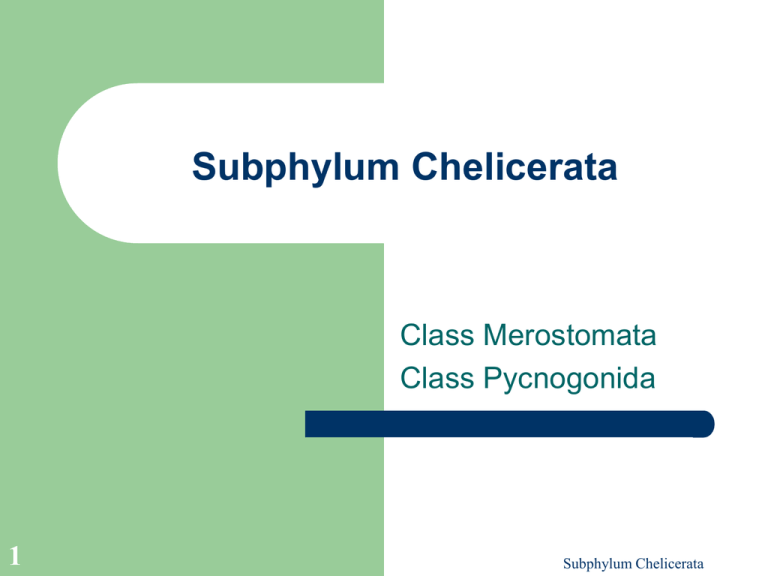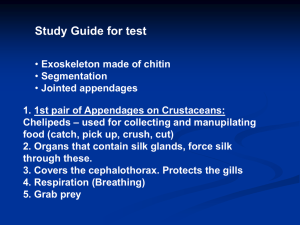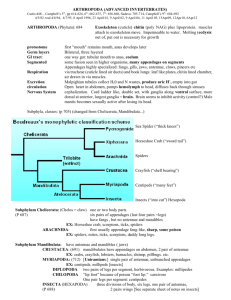Subphylum Chelicerata Class Merostomata Class Pycnogonida 1
advertisement

Subphylum Chelicerata Class Merostomata Class Pycnogonida 1 Subphylum Chelicerata Subphylum Chelicerata Defining characteristics – 2 Absence of antennae Contains three classes, most of the animals are terrestrial and freshwater Marine species are horseshoe crabs, sea spiders, and mites Subphylum Chelicerata Chelicerate Segmentation 3 Cephalothorax –usually has 6 pairs of appendages – First pair – chelicerae – Second pair – pedipalps – Both function as mouthparts – The rest are walking legs Subphylum Chelicerata Taxonomic Summary Phylum Arthropoda – Subphylum Chelicerata 4 Class Merostomata Class Pycnogonida Subphylum Chelicerata Class Merostomata Defining characteristics – – 5 Appendages on the abdomen are flattened and modified for gas exchange as “book gills” Terminal portion of body drawn out into an elongated spike Only 4 living species; the horseshoe crabs Subphylum Chelicerata Horseshoe Crab Habits 6 The cephalothorax and abdomen are covered by a hard non-jointed carapace Subphylum Chelicerata Merostomata Appendages 7 Possess an anterior chelicerae and 5 pairs of walking legs In males the first pair of walking appendages are modified for grasping the female during reproduction All the legs (except the last pair) bear pinchers for manipulating food Walking legs bear gnathobases on basal part of legs, which aid in food manipulation Subphylum Chelicerata Respiration 9 The abdomen bears the book gills and is endowed with blood The blood or components of it are used in pharmaceutical research Subphylum Chelicerata Reproduction 10 Subphylum Chelicerata Class Pycnogonida Defining characteristics – – 11 Body is not divided into distinct regions Unique proboscis at the anterior end, with an opening at its tip Includes the sea spiders, several of which are common in our area Feed on soft bodied invertebrates, hydroids, bryozoan colonies, and sponges Subphylum Chelicerata Sea Spiders 12 Have a long proboscis for feeding and a digestive tract with gonads extending into the walking legs Difficult to discern the cephalothorax, and abdomen Anterior appendages may bear cheliceras that grasp pieces food Subphylum Chelicerata Sea Spiders Ovigers – structures used by males to carry eggs on the body – 13 When eggs are mature they are deposited in a hydroid colony Subphylum Chelicerata


